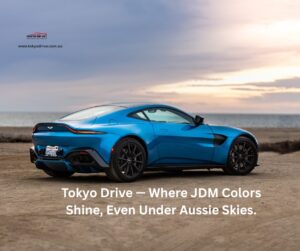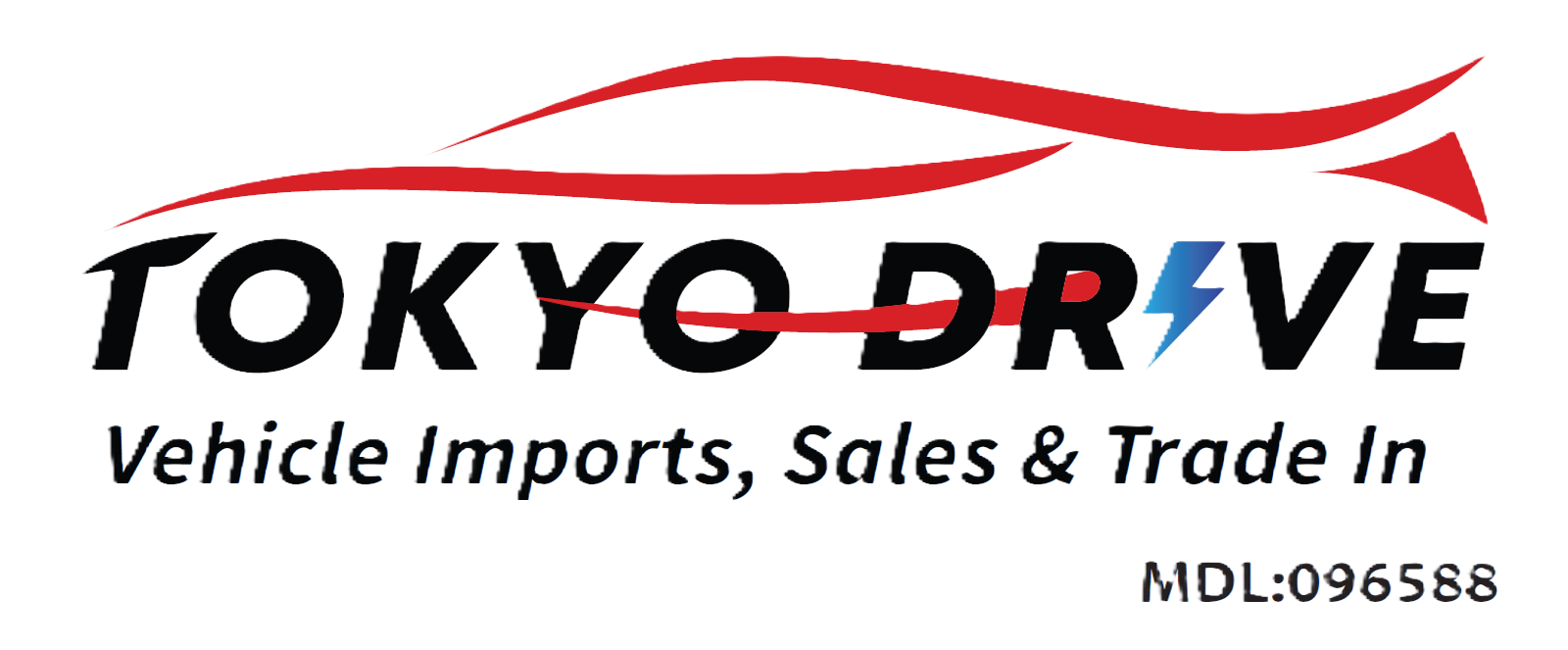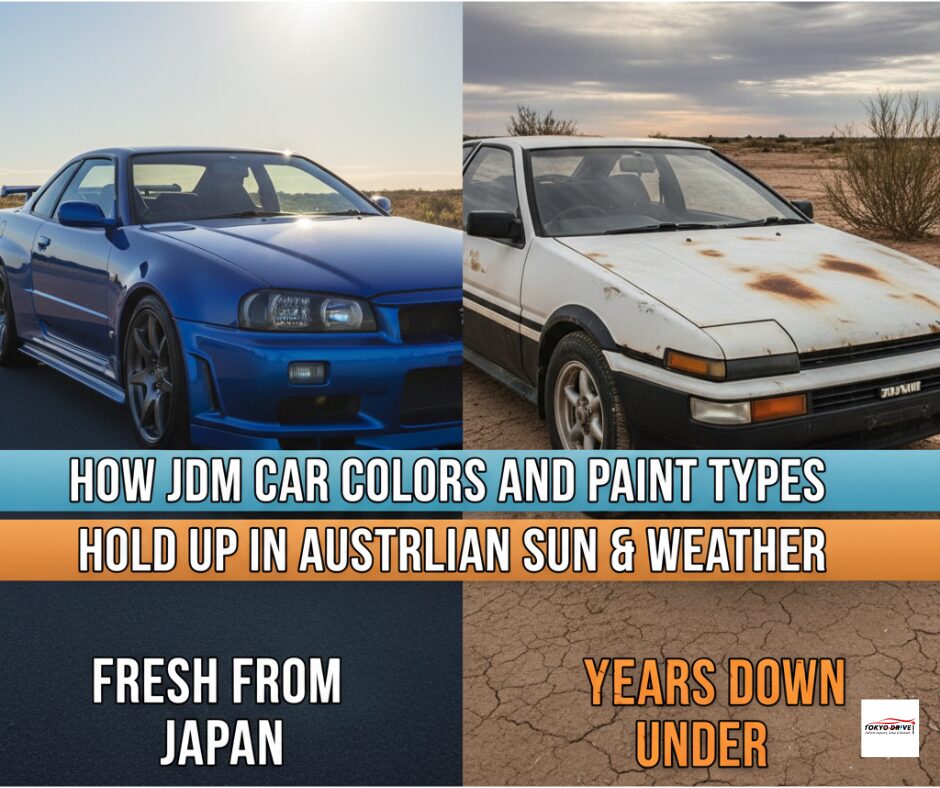If you’ve ever owned a Japanese Domestic Market (JDM) car in Australia, you’ve probably noticed how the sun loves to test your paintwork. The deep reds fade, the glossy blacks turn hazy, and even the brightest whites begin to yellow over time. It’s not just bad luck — it’s science and environment working against your car’s factory finish.
In Japan, JDM cars enjoy milder conditions — shorter summers, less UV intensity, and more cloud cover. But in Australia’s harsh sunlight and coastal climate, the same paint that shines in Tokyo can struggle to hold up over the years.
So, if you’re driving a Japanese import in Sydney, Brisbane, or Perth, here’s how JDM paint types react under Aussie conditions — and what you can do to keep your car looking as good as the day it arrived.
1. Why the Australian Climate Is So Tough on Paint
Australia has one of the highest UV radiation levels in the world — around 40% stronger than Japan on average. This means your car’s clear coat, pigments, and surface layers are constantly battling UV degradation, heat stress, and oxidation.
-
UV light breaks down clear coat polymers, causing that chalky, cloudy look.
-
High temperatures cause paint to expand and contract, leading to micro-cracks.
-
Coastal humidity and salt air corrode metal and eat through weak clear coats faster.
In short: even a garage-kept car in Australia experiences more wear in five years than it might in ten years in Japan.

2. Factory JDM Paints: Stunning but Sensitive
JDM cars are known for their unique factory colors — deep metallics, pearl finishes, and rare shades that never made it to export models. Think Midnight Purple (Nissan R34), Championship White (Honda Type R), and Bayside Blue (Skyline GT-R). These paints are visually stunning, but not all are equally durable under Australian conditions.
Let’s look at how different paint types perform:
| Paint Type | Common JDM Example | Performance in Australian Weather |
|---|---|---|
| Solid Colors | Championship White, Milano Red | Simple and durable, but bright reds fade fastest under UV. |
| Metallic Paints | Bayside Blue, Sonic Silver | Better at hiding dust and small scratches, but metal flakes amplify sun glare, increasing heat absorption. |
| Pearlescent / Mica Paints | Midnight Purple, Premium Silver | Beautiful depth and shine, but require delicate maintenance. Clear coats on older imports often fail faster in Australian UV. |
| Matte Finishes (Rare) | Some aftermarket or custom JDM builds | Extremely sensitive — can discolor quickly without ceramic or UV protection. |
3. Which JDM Colors Fade the Fastest?
Not all colors handle sunlight the same way. Certain pigments are more prone to UV breakdown, and older paints often lack modern UV inhibitors. Here’s a quick rundown:
-
🔴 Red & Orange — These pigments absorb high-energy wavelengths, making them fade the quickest. The once-vibrant Milano Red on Civics and Integras can turn pinkish without care.
-
⚫ Black — Looks amazing when clean, but absorbs more heat than any color. The result? Oxidation and visible swirl marks appear faster.
-
⚪ White — Surprisingly durable, but lower-quality single-stage whites can develop yellowing or chalkiness.
-
🔵 Blue & Purple — Metallic and pearlescent blues (like Bayside Blue) resist fade well, but deep purples like Midnight Purple can lose depth and clarity over years of UV exposure.
-
🟢 Silver & Grey — The best performers overall. These colors reflect more light, show less dust, and resist visible fading the longest.
4. How Humidity and Coastal Air Affect JDM Finishes
Sydney, Brisbane, and Perth share one common challenge — coastal air and humidity. Salt particles in the air settle on paint and metal, slowly causing corrosion. Combine that with intense sunlight, and even a small clear coat crack can become a full-blown patch of oxidation within months.
JDM cars are particularly at risk if:
-
They were previously garage-kept in Japan and are now parked outdoors daily.
-
They came with older single-stage paints (common on 1990s models).
-
They have aftermarket repaints with limited UV protection.
Even modern ceramic coatings can wear thin faster near the coast, so maintenance frequency matters more than coating brand.

5. How to Protect Your JDM Paint from the Australian Elements
You can’t change the climate, but you can protect your paint. Here’s what the pros recommend for JDM cars down under:
✅ 1. Regular Washing
Salt, dust, and bird droppings accelerate paint damage. Wash your car weekly using pH-neutral shampoo. Avoid harsh detergents that strip wax or coatings.
✅ 2. UV-Resistant Wax or Ceramic Coating
A high-quality ceramic coating provides an extra UV shield and makes cleaning easier. For older cars, layering wax every 2–3 months also helps reduce oxidation.
✅ 3. Shade and Covers
If you can’t park in a garage, use a UV-reflective car cover or park in shaded areas. Even 30% less sun exposure dramatically slows fading.
✅ 4. Paint Correction for Older Imports
If your clear coat is dull or hazy, professional paint correction and re-clear coating can restore gloss and extend life. Many JDM imports benefit from this after arriving from Japan’s humid storage conditions.
✅ 5. Avoid Automatic Car Washes
The harsh brushes used by automatic washes can micro-scratch soft JDM clear coats. Always wash by hand with microfiber cloths.
6. The Role of Modern Repaints and Color Restoration
Many JDM owners choose to respray their cars in the original factory color — and it’s a smart move. Modern automotive paints, even when color-matched to classic shades, come with advanced UV-blocking technology that wasn’t available in the 1990s or early 2000s.
For example:
-
Modern 2K clear coats are far more resistant to oxidation and UV haze.
-
Nano ceramic pigments reflect UV rays and retain vibrancy longer.
-
Professional paint shops in Australia can apply UV-tolerant base coats specifically formulated for local conditions.
If you’re restoring an imported Skyline, RX-7, or Supra, investing in a high-quality local repaint might preserve both appearance and resale value far better than preserving an aging factory coat.
7. Long-Term Care for JDM Paint in Australia
Here’s a simple long-term plan to make your paint last:
| Task | Frequency | Purpose |
|---|---|---|
| Wash (pH-neutral) | Weekly | Remove salt and dirt before they etch the surface |
| Apply Wax / Sealant | Every 2–3 months | Add UV protection |
| Inspect Clear Coat | Every 6 months | Spot cracks or oxidation early |
| Re-coat Ceramic Protection | Every 1–2 years | Renew surface layer |
| Paint Correction / Polish | Every 12–18 months | Revive gloss and remove oxidation |
| Professional Detail | Yearly | Deep clean and check for paint degradation |
Final Thoughts: Shine Smart, Not Just Bright
Owning a JDM import in Australia is a badge of pride — it’s about craftsmanship, performance, and style. But with that pride comes responsibility. The Australian sun can be unforgiving, especially to delicate JDM paint formulas that weren’t designed for it.
Whether you’re preserving your Bayside Blue R34 or a Championship White Type R, the secret is consistent care and UV protection. With the right maintenance routine, even the most delicate JDM colors can keep their factory shine for decades — turning heads on the road without losing their sparkle to the sun.



